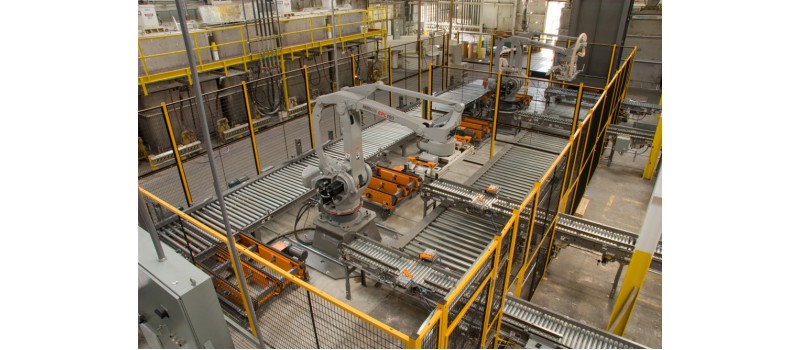Moving machine parts can potentially cause severe workplace injuries, such as crushed fingers or hands, amputations, burns, or blindness. In addition, amputations, lacerations, and abrasions are costly and potentially increase workers' compensation premiums. (Amputation is one of the most severe and crippling types of injuries in the occupational workplace, often resulting in permanent disability.) Due to this fact, OSHA (Occupational Safety & Health Administration) has established a set of standards around machine guarding. The purpose of machine guarding is to protect the machine operator and other employees in the work area from hazards created during the machine's regular operation. That would include risks of concern such as ingoing nip points, rotating parts, reciprocating, transversing, and flying chips & sparks.
Any machine part, function, or process that might cause injury must be safeguarded. When the operation of a machine or accidental contact with it could injure the operator or others in the vicinity, the hazards must be controlled or eliminated.
Barrier railing and machine guards are used in various industries to enhance safety measures and prevent accidents. Here are some guidelines for their use:
Barrier Railing:

- Determine the areas where barrier railing is required: Typically, barrier railing is used to protect people from falling from heights, prevent vehicles from entering restricted areas, or cordon off hazardous zones.
- Choose the appropriate type of barrier railing: Barrier railings come in various materials, such as steel, aluminum, and plastic. They also come in different designs, such as handrails, guardrails, and railings. Choose the appropriate type based on the intended purpose and the environment.
- Install the barrier railing correctly: Follow the manufacturer's instructions carefully and ensure that the barrier railing is securely installed. The barrier railing should be strong enough to withstand the intended loads and impacts.
Machine Guards:

- Identify the hazards: Identify the risks associated with the machine and determine the type of guard required. For example, moving machinery parts may require an enclosure guard, while the point of operation may require a fixed guard.
- Select the appropriate type of machine guard: There are several types of machine guards, such as fixed, adjustable, interlocked, and self-adjusting. Select the appropriate variety of guards based on the hazard and the type of machinery.
- Install the machine guard correctly: Follow the manufacturer's instructions carefully and ensure that the guard is securely installed. In addition, the guard should be positioned so that it does not interfere with the machine's operation.
- Train employees: Train employees on the proper use and maintenance of the machine guard. Emphasize the importance of using the guard and the consequences of not using it.
Overall, barrier railing and machine guards are essential safety features that should be used to prevent accidents in the workplace. However, proper installation, maintenance, and employee training are crucial to ensuring their effectiveness.
Note: Always follow the manufacturer's instructions and safety guidelines when using this product. In summary, following the manufacturer's guidelines is generally a good idea when using any product or equipment. Still, it's also essential to use your judgment and seek expert advice when necessary.
Benefits of Machine Guards and Barrier Railing for Industrial Use.
Machine guards and barrier railings are crucial in ensuring safety and security in industrial settings. Here are some benefits of using machine guards and barrier railings:
-
Accident Prevention: Machine guards are designed to protect workers from hazardous machine parts, such as rotating blades, gears, or moving belts. They create a physical barrier between workers and machines, preventing accidental contact and reducing the risk of injuries.
-
Personnel Protection: Barrier railings create restricted areas or safety zones within industrial facilities. They help prevent unauthorized access to dangerous machinery or hazardous areas, protecting employees and visitors from potential harm.
-
Compliance with Regulations: Many countries have specific safety regulations and standards requiring machine guards and barrier railings in industrial settings. By implementing these safety measures, companies can ensure compliance with legal requirements and avoid penalties or legal issues.
-
Increased Productivity: By promoting a safe working environment, machine guards and barrier railings can enhance productivity. Workers who feel secure and protected can focus more on their tasks without worrying about potential accidents or injuries, leading to improved efficiency.
-
Equipment Protection: Machine guards protect workers and shield machinery from external factors that could cause damage. They can prevent debris, dust, or accidental collisions from affecting the performance and longevity of expensive equipment, reducing maintenance costs and downtime.
-
Risk Mitigation: Machine guards and barrier railings are essential risk mitigation measures. They minimize the likelihood of accidents, injuries, and property damage, which can have significant financial and operational consequences for businesses. By proactively addressing potential risks, companies can minimize liabilities and maintain a safer working environment.
-
Enhanced Safety Culture: Installing machine guards and barrier railings demonstrates a company's commitment to safety and employee well-being. It fosters a culture of safety within the organization, encouraging workers to prioritize their safety and the safety of others. This can increase employee morale and job satisfaction and reduce turnover rates.
-
Insurance Premium Reduction: Implementing appropriate safety measures, including machine guards and barrier railings, can help lower insurance premiums. Insurance companies often consider the safety precautions a company takes when determining insurance rates. By investing in safety equipment, businesses can potentially save on insurance costs in the long run.
Remember that the specific benefits may vary depending on the industry, the nature of the work being performed, and the regulatory requirements in different countries or regions. It's essential to assess the specific needs and risks of your industrial setting and consult relevant safety guidelines and experts to determine the most suitable machine guards and barrier railings for your particular requirements.
Note: Always follow the manufacturer's instructions and safety guidelines when using this product. Following the manufacturer's guidelines is generally a good idea when using any product or equipment. Still, it's also essential to use your judgment and seek expert advice when necessary. Specifications are subject to change without notice.
Link to: Barrier Railing and Machine Guards






































